Cricket World Cup 2015: Are too many runs being scored?
- Published
- comments
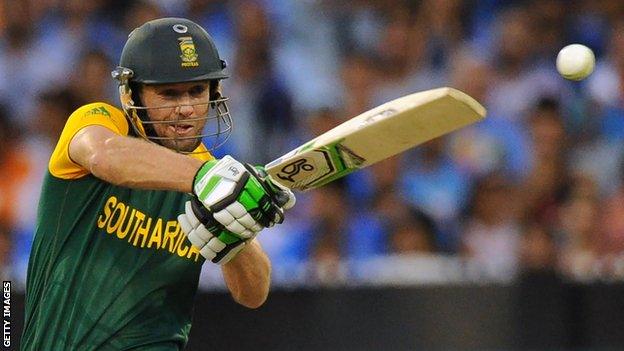
South Africa captain AB de Villiers has hit 20 sixes in the World Cup, more than any other player
It is enough to make bowlers pack up their boots and take the first flight home.
If it's not Chris Gayle heaving over the leg side, it's Brendon McCullum charging down the pitch and flat-batting through the covers. If it's not Kumar Sangakkara torturing fielders like a sadistic surgeon, it's AB de Villiers sweeping fast bowlers for six - with one hand.
The 2015 World Cup has been the most run-thirsty of all time: record scores, more sixes and more centuries than ever before. Fielders have become spectators and spectators have become fielders.
Why is the bat so dominant? Why are bowlers so powerless? And does a run-fest actually make good cricket?
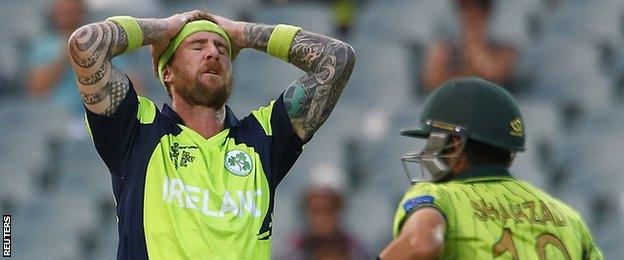
Bowlers are allowed only four fielders outside the 30-yard circle, and three during powerplays
The numbers
In case you need proof, the statistics provide conclusive evidence that this World Cup in Australia and New Zealand has been all about the batsmen.
With seven matches still to play, there have already been more team totals over 300 (25), more centuries (35) and more sixes (388) than any other World Cup
Australia's 417-6 against Afghanistan is the highest World Cup total
Chris Gayle's 215 for West Indies against Zimbabwe is the highest individual score in the tournament's history
Teams are scoring faster than any other World Cup - 5.63 runs per over
Bowlers are finding wickets harder to come by - they cost 32.71 runs each
New Zealander Brendon McCullum's 18-ball fifty against England was the fastest World Cup half-century
South Africa's AB de Villiers hit the quickest 150, off 64 balls, against West Indies
Sri Lanka's Kumar Sangakkara became the first man to score hundreds in four successive one-day internationals
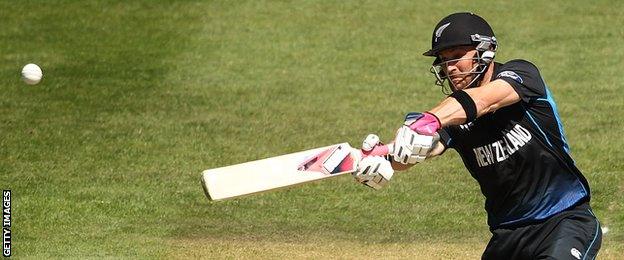
New Zealand's Brendon McCullum hit 77 off 25 balls against England and 50 off 24 against Australia
The Twenty20 effect
Much is made of the advantages given to batsmen - better bats, smaller boundaries, pitches that encourage dazzling strokeplay.
But the increase in runs is most often attributed to the 2012 change in ODI playing conditions. Whereas teams were once allowed five fielders outside the 30-yard circle, they can now have only four.
Cricket World Cup 2015: World Cup's record-breaking pool stage
"If you have one less man outside the ring, batters are targeting where the gap is," Ireland batsman Ed Joyce told BBC Sport.
"The skill level of the batters is exceptionally good and they are making bowlers bowl differently. When bowlers do something they don't want to do, they don't do it as well."
However, the change in regulations does not fully explain the heavy scoring, because batsmen are only just taking full advantage.
At the 2011 World Cup, the average runs per over was 5.03, while between 2013 and 2014 it was 5.20. In this tournament, that figure has jumped to 5.63.
With Twenty20 now more than 10 years old and fully embedded into a batsman's psyche, are we seeing the shortest form of the game finally impose a total influence on 50-over cricket?
"The batsmen have taken T20 cricket into the one-day game," said former Australia all-rounder Andrew McDonald.
"They have taken it to a new level with so many shots, the ability to score through 360 degrees. They have the confidence to play them in any game."
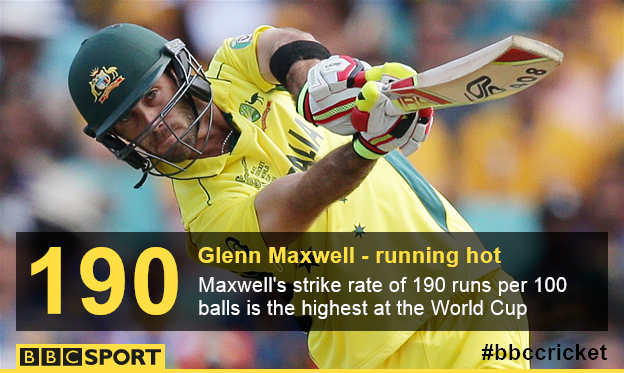
Could a team score 500 in 50 overs?
Have batsmen drunk the bar dry or is there an inexhaustible supply of runs to be lapped up? The facts provide no optimism for bowlers.
This is the third successive World Cup where the average runs per over and the number of totals in excess of 300 have both increased.
Cricket World Cup 2015: Australia on the attack - Vic Marks
The records for the fastest fifty, century and 150 have all been broken in 2015 and all five individual scores of 200 have come since 2010. Rohit Sharma's record score of 264, made against Sri Lanka last year, hinted that an ODI triple century is possible.
"At the moment, who knows? We are seeing so many different shots with so much power," said Australia captain Michael Clarke.
"Someone like David Warner, Chris Gayle or AB de Villiers - on a smaller ground they possibly could make 300."
The good news - if you can call it that - for bowlers is that the record for the highest team total in ODIs is yet to be threatened. Although this World Cup has seen three scores in excess of 400, Sri Lanka's record of 443-9,, external made against the Netherlands, has stood since 2006.
Still, there are those who believe 500 is within reach.
"There's a very good chance that a team could get 500, especially on a small ground," said Joyce. "The way batsmen play without fear, it's incredibly difficult to stop them scoring."
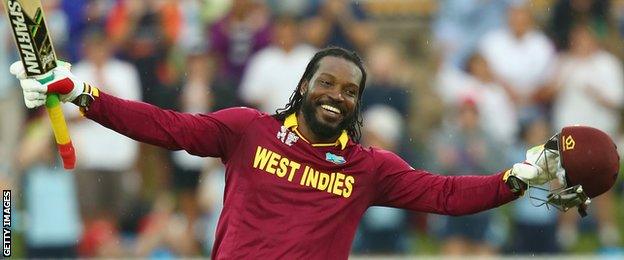
Chris Gayle is the only player to make a T20 century, an ODI double hundred and a Test triple century
What can bowlers do about it?
At the moment, not a great deal.
Even a rule change that was thought likely to help bowlers has gone the other way. Using two balls, one at each end, was supposed to offer more assistance, but instead keeps the balls harder for longer so they travel further and faster off the bat.
"It's always tough to be a bowler. All the rules are against us," said South Africa pace bowler Dale Steyn.
"We're starting to realise if bowlers can go for between eight runs and 10 an over in the last 10, you're actually doing a pretty good job."
Those who have made the ball swing - the likes of Australia's Mitchell Starc and New Zealand pair Tim Southee and Trent Boult - have had success, but how do bowlers curb scoring when there is no assistance, particularly in the final overs of an innings?
"There are different theories - bowl short to use the square fielders - but I still feel the yorker is the best ball," said Pakistan coach Waqar Younis.
"I'm glad I'm not playing, because it is unfair to bowlers."
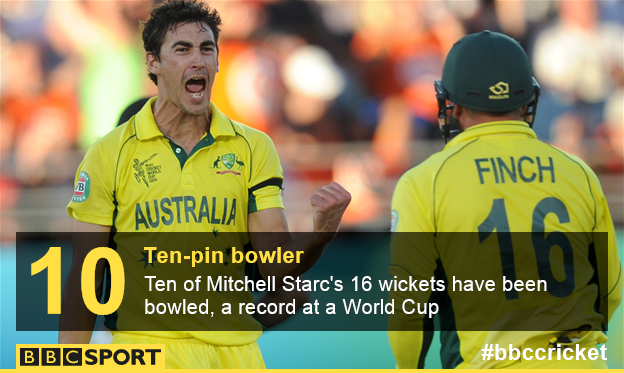
Do more runs mean more exciting cricket?
Seeing the ball constantly flayed to the boundary might be entertaining for some, but it makes for one-sided contests in more ways than one. Not only is the ball struggling to compete with the bat, but a huge first-innings total often means the game is over by the halfway stage.
World Cup 2015: Quarter-finals preview with Jonathan Agnew
Of the 20 completed World Cup games in Australia, 14 have been won by the side batting first. On the 20 occasions across the whole tournament that a team have posted in excess of 300, the side batting second have won only three times.
"A massive first-innings score kills the game," said BBC cricket correspondent Jonathan Agnew. "The team batting second is under so much pressure that they feel they have to go hard all the way through. They lose early wickets, then the game is gone."
In contrast, some of the most thrilling matches have been low-scoring. New Zealand chased Australia's 151 to win by one wicket, the same for Afghanistan as they overhauled Scotland's 210.
"The world wants entertainment, fours and big sixes," said Waqar. "Weighting the game in favour of the batsmen is a crowd-pulling thing, but it should be an even contest."
What does it mean for Test cricket?
The speed of Test run scoring has been increasing for some time. Of the seven completed Test innings with a run-rate above five per over, only three happened between 1902 and 2005, but four have come since 2012.
The very best batsmen - the likes of De Villiers and Sangakkara - are always best placed to have success across all forms of the game, but players like Australia's Warner, who made his name in limited-overs cricket, are transferring to the Test arena.
However, Tests will always provide a fairer battle between bat and ball: no boundary fielding restrictions, red leather more likely to swing, and pitches that deteriorate over five days.
"ODIs are so weighted in favour of the batters, but Test cricket is completely different," said Joyce.
"The Test mindset is different. There's been some increase in Test scoring, but I don't see any reason why it would get to the level of ODIs."
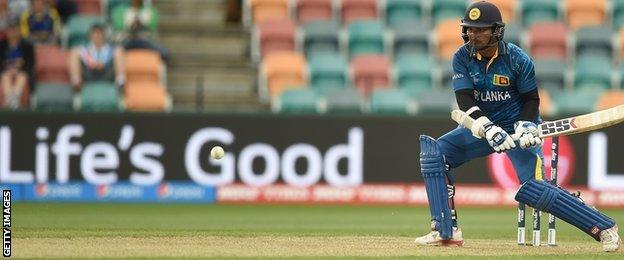
Kumar Sangakkara is the leading run scorer in the World Cup, with 496 at an average of 124
- Published17 March 2015

- Published16 March 2015

- Published23 March 2015
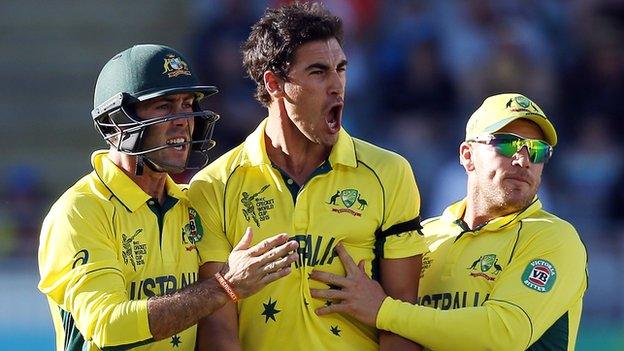
- Published16 March 2015

- Published30 July 2013

- Published15 May 2018

- Published18 October 2019
